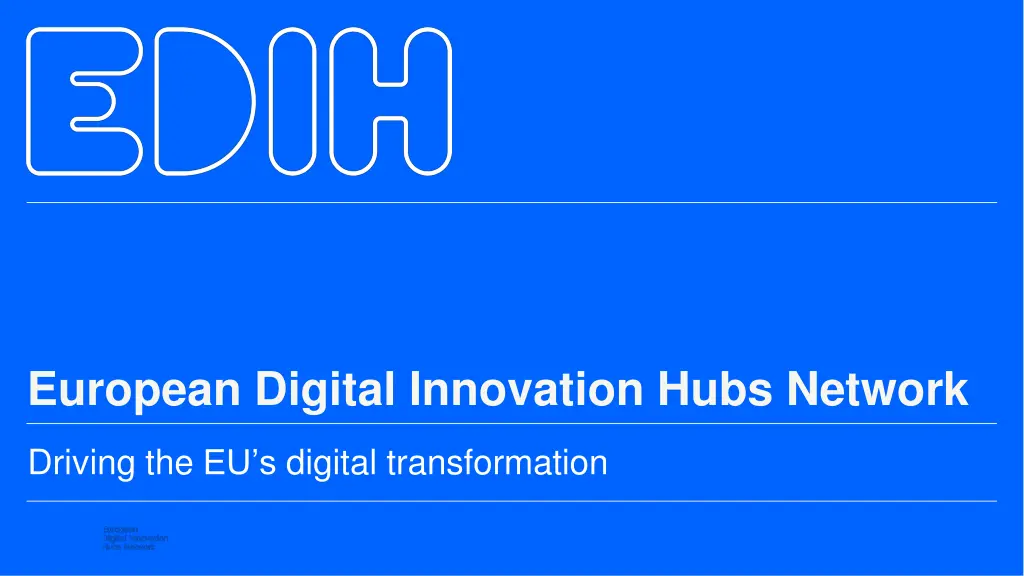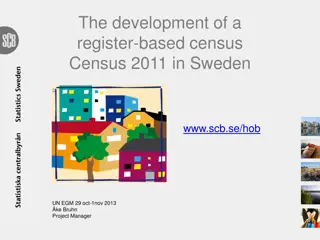
Driving Digital Innovation in Sweden's European Digital Hubs Network
"Explore how Sweden's European Digital Innovation Hubs Network is transforming key sectors like healthcare, education, manufacturing, and more through technological advancements. Discover success stories and focus areas driving Sweden's digital transformation."
Download Presentation

Please find below an Image/Link to download the presentation.
The content on the website is provided AS IS for your information and personal use only. It may not be sold, licensed, or shared on other websites without obtaining consent from the author. If you encounter any issues during the download, it is possible that the publisher has removed the file from their server.
You are allowed to download the files provided on this website for personal or commercial use, subject to the condition that they are used lawfully. All files are the property of their respective owners.
The content on the website is provided AS IS for your information and personal use only. It may not be sold, licensed, or shared on other websites without obtaining consent from the author.
E N D
Presentation Transcript
European Digital Innovation Hubs Network Driving the EU s digital transformation
Sweden EDIH SoE 11 4/11 *EDIHs 11 Members 7/11 **SoEs 10 29 Sectors EDIHs in Sweden 9 8 Include sectors such as healthcare, life sciences, and personal services to showcase Sweden's dedication to digital solutions in these areas, which are vital for advancing public health and improving the quality of services. Address sectors such as education, energy, environment, and transportation to highlight the essential role of digital innovation in enhancing education, promoting sustainability and improving transportation infrastructure. Focus on key sectors such as manufacturing, automotive, metalworking, and industrial production. Highlight the critical role of digital innovation in these traditional industries and their significant potential for transformation through technology. 7 1-4 6 5 *European Digital Innovation Hubs **Seal of Excellence (SoE) *Funded under Digital Europe Programme
Network overview: 11 members 4 EDIHs Aero EDIH DigIT Hub Sweden ShiftLabs Health Data Sweden (HDS)
Network overview: 11 members 7 SoE Agrihub Sweden AI Sweden EDIH AM-EDIH AI Sweden EDIH Agrihub Sweden AM-EDIH Digital Impact North (DIN) Sweden Secure Tech Hub by Sweden ICT MIGHTY EDIH IndTech
33 Technologies Services Swedish EDIHs prioritise facilitating technological innovation and technology transfer, helping businesses adopt the latest advancements. Swedish EDIHs emphasise additive manufacturing, highlighting a strong interest in advanced manufacturing technologies. While the focus on artificial intelligence is relatively low, it remains an important area of involvement for Swedish EDIHs. A strong focus on supporting SMEs reflects Swedish EDIHs' dedication to driving digital transformation and enhancing competitiveness in various sectors. EDIHs are deeply engaged in a broad range of technologies, including robotics, simulation engineering, modelling, and the internet of things (IoT), underscoring their commitment to technological advancement and industrial transformation. Although the focus on the circular economy is relatively lower, the services provided by Swedish EDIHs are geared toward fostering innovation and competitiveness across multiple industries. https://european-digital-innovation-hubs.ec.europa.eu/home
Success stories A new era in blood sampling: transforming the future of diagnostics Challenges Service type EDIH Test before invest Blood Simpling AB faced the challenge of high failure rates in venous blood sampling, especially for patients with difficult veins. This led to discomfort for patients and wasted time and resources in healthcare settings, as multiple attempts were often needed to complete a successful blood draw. The company aimed to address this inefficiency and improve the overall patient experience through innovation. Technologies CUSTOMER Blood Simpling Website Micro-sized enterprise with 1-9 employees. Artificial intelligence and decision support Solutions EDIH Health Data Sweden helped Blood Simpling AB develop a prototype for an innovative device to improve blood sampling: supported the development of prototype; gathered feedback from healthcare professionals to enhance the device s design; provided expert mentorship development. an improved blood sampling Sectors Healthcare and guidance during product
Success stories A new era in blood sampling: transforming the future of diagnostics Results and benefits Thanks to EDIH Health Data Sweden the SME achieved:: Reduced failure rates in venous blood draws The improved device addressed the core problem, lowering the number of unsuccessful blood draws, which is crucial for reducing patient discomfort and improving efficiency in healthcare settings. accelerated product development: Blood Simpling AB was able to significantly speed up the development process of their blood sampling device. This included refining the design and making the prototype more viable for real-world applications, bringing them closer to a market-ready product much faster than anticipated; Minimised patient discomfort By reducing the need for multiple attempts, the device significantly improved the patient experience, especially for those with challenging veins. Enhanced healthcare efficiency The new device saved time and resources by reducing the need for repeated procedures. incorporated real-world insights: feedback from healthcare professionals helped refine the prototype, ensuring the device met practical needs; thanks to the improved feedback and expert guidance, Blood Simpling AB created a more intuitive and ergonomic design. This made the device easier to use in clinical environments, improving efficiency and reducing strain on medical professionals. user-friendly design: Lessons learnt User-centred design: involving healthcare professionals in the development phase is crucial for creating a device that meets real-world needs. Iterative prototyping: the process of refining prototypes through iterative testing and feedback accelerates product development and ensures a better end product.
Good practices Smart maintenance technologies: challenges, solutions and benefits Challenges Solution EDIH Implementing technologies in the manufacturing industry comes with several organisations struggle understanding of technologies, such as IoT, AR, and AI, which makes it difficult to know what data to collect and monitor Cybersecurity is another major concern, as protecting data and systems is crucial. Additionally, aligning technologies with existing company goals can be challenging, making it hard to fully capitalise on the maintenance. smart maintenance To address these issues, a test bed for smart maintenance demonstrate how Industry 4.0 technologies can be applied effectively. Services was created to hurdles. with Industry Many Networking and access to innovation ecosystems, test before invest and training and skills development a lack of 4.0 This includes IoT sensors, AR for remote maintenance, AI for data analysis, and autonomous robots. Technologies Internet engineering and modelling, cloud services, virtual reality effectively. All integrated using systems like OPC-UA and MQTT. Additionally, a lab for No-code AI was developed to make it easy for anyone to create AI models without needing to code, as users choose the type of AI model to upload data and train the model, making solutions more accessible for maintenance teams. these elements are seamlessly of things, simulation these new benefits of smart Sectors Manufacturing and processing
Good practices Smart maintenance technologies: challenges, solutions and benefits Lessons learnt Prioritise in-person sessions: facilitates richer discussions and networking. Results and benefits Enhanced maintenance AR improves accuracy, smart sensors enable predictive maintenance, and No Code AI simplifies decision-making. Social and economic impact Shiftlabs merges human skills, boosting efficiency and reducing downtime. Measurable knowledge growth Shiftlabs significantly knowledge gaps in areas like AI and IoT. Participants understanding of these technologies, improving their ability to implement smart maintenance practices effectively. Adaptability: be flexible with online sessions when in-person sessions are not feasible. Encourage interaction: allocate time for open discussions and questions. Provide clear next steps: ensure attendees know how to engage further, with easy access to resources. Communicate EDIH value: clearly explain EDIHs, their services and client journeys to SMEs. technology with reduced gained a deeper Integrated framework for smart maintenance implementation






















